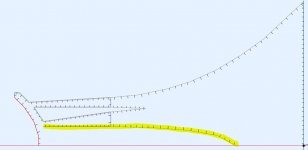Last edited:
Interfaces are a special case of calculation where it does not matter in absolute terms which way the normals face. The only rule is that they must point into the subdomain listed first when specifying the interface.
So these should work the same:
One thing that I think is important is to have the interface defining the transition to an external subdomain type at the mouth of the horn. I’ve had some odd results trying it in other ways, even using a full 3D mesh.
@mabat: have you tried adding an extra node, and defining an interface from P3 to that?
So these should work the same:
Code:
Elements "Interface"
RefNodes="Nodes"
Subdomain=1,2
1 2 8
Code:
Elements "Interface"
RefNodes="Nodes"
Subdomain=2,1
1 8 2One thing that I think is important is to have the interface defining the transition to an external subdomain type at the mouth of the horn. I’ve had some odd results trying it in other ways, even using a full 3D mesh.
@mabat: have you tried adding an extra node, and defining an interface from P3 to that?

Believe it or not, turning the direction of the interface helped! Now I get the same results.
I'm not sure I would try that without you mentioning that it shouldn't make a difference...
Well I’m glad to have helped, even if that doesn’t make sense 🙂
Perhaps ABEC is stricter on that than Akabak? I might have to check the ported cabinet example, as that’s a case where both of the interfaces specified for the port face ‘into’ the port volume. It works with them both facing ‘out’ too, so long as you change the subdomain set as the source to be the port volume.
Perhaps ABEC is stricter on that than Akabak? I might have to check the ported cabinet example, as that’s a case where both of the interfaces specified for the port face ‘into’ the port volume. It works with them both facing ‘out’ too, so long as you change the subdomain set as the source to be the port volume.
Interesting thing is that I also get correct results without swapping the normal just by moving position of the interface surface to the end of the pipe (although there are slight differences in radiation impedance)

(this script from mabats post).

(this script from mabats post).
Last edited:
Love it! I guess there is something interesting in the first simulations since you went artistic already, cant wait!😀
Last edited:
Probably.
The next step is to optimize this to produce a spherical wave at the exit of the channels. Than we could use it as a block and optimize waveguides driven with a simple spherical cap of that size, which should be a lot easier than to simulate it as a one big system. Now it all depends on how well will ABEC or AKABAK allow to handle this problem. There is some hope.
The next step is to optimize this to produce a spherical wave at the exit of the channels. Than we could use it as a block and optimize waveguides driven with a simple spherical cap of that size, which should be a lot easier than to simulate it as a one big system. Now it all depends on how well will ABEC or AKABAK allow to handle this problem. There is some hope.
Attachments
Last edited:
Maybe one option would be to place a spherical cap as an absorptive boundary over the exits and inspect the pressures at the ends of the channels, i.e. to treat it solely as an interior problem. We saw already that the absorption works only for waves with velocity normal to the boundary but that should not be a problem here I guess. The closer the better.
So I have it in ABEC, this is the first experiment - standing waves inside the channels closed (the steady state).
This is what I would like to see:

This, not so much -

As it is, the channels are closed by a straight line segment, it should be a circular arc. Maybe it's not that negligible.
At this point there are so many questions that it will take me a while to sort it out...
This is what I would like to see:
This, not so much -
As it is, the channels are closed by a straight line segment, it should be a circular arc. Maybe it's not that negligible.
At this point there are so many questions that it will take me a while to sort it out...
Attachments
My simulations didn't look as good 😀
The whole thing breaks up after 9khz in my simulation.
I think a circular arc will make it worse at higher frequencies as it will act as a lens.
Have you tried to make the "cap" 100% absorbent and see how it looks?
In my simulation I had the feeling that the outer most channel seemed too long even though the average length was the same for all of them.
Would you mind sharing your abec/akabak script?
The whole thing breaks up after 9khz in my simulation.
I think a circular arc will make it worse at higher frequencies as it will act as a lens.
Have you tried to make the "cap" 100% absorbent and see how it looks?
In my simulation I had the feeling that the outer most channel seemed too long even though the average length was the same for all of them.
Would you mind sharing your abec/akabak script?
Last edited:
Attached.Would you mind sharing your abec/akabak script?
Attachments
- Home
- Loudspeakers
- Multi-Way
- Acoustic Horn Design – The Easy Way (Ath4)













